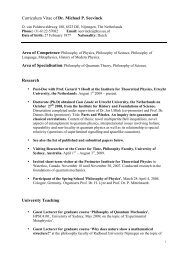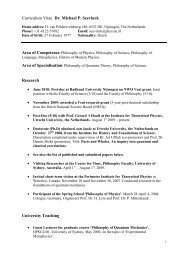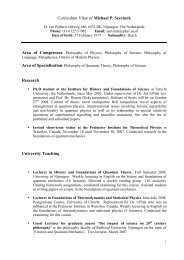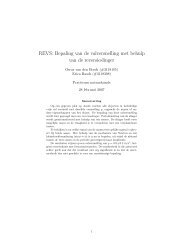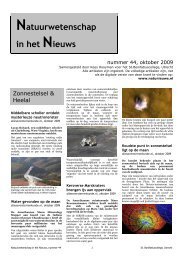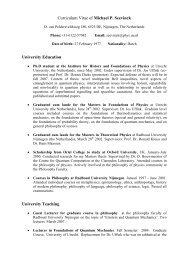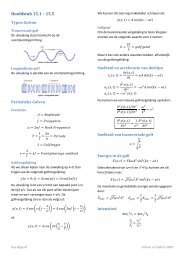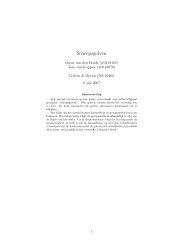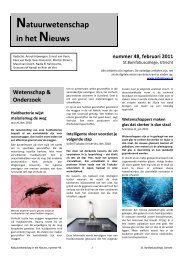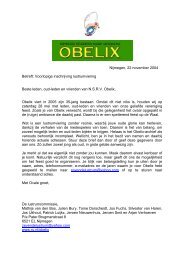Exercise sheet 2: 10 Mar
Exercise sheet 2: 10 Mar
Exercise sheet 2: 10 Mar
Create successful ePaper yourself
Turn your PDF publications into a flip-book with our unique Google optimized e-Paper software.
<strong>Exercise</strong> <strong>sheet</strong> 2: <strong>10</strong> <strong>Mar</strong><br />
NS-TP431: Introduction to black holes (spring 2009)<br />
The exercises are to be handed in during exercise class or brought to Timothy Budd in office<br />
MG 418 before 20 <strong>Mar</strong>, 5pm. The exercises will not be graded, but we expect all exercises to<br />
be done and we will try to give feed-back when necessary.<br />
1. Energy-momentum conservation. Show that the energy momentum conservation<br />
D µ T µν = 0 follows from the Bianchi identity and Einstein’s equations.<br />
2. Newtonian limit. Let’s consider the Newtonian limit in which the metric is given by<br />
g µν = η µν + h µν , (1)<br />
where h µν is viewed as infinitesimal with respect to the Minkowski metric.<br />
(a) Show that the Christoffel symbols, the Ricci tensor and the Ricci scalar to first order<br />
in h are given by<br />
Γ α µν = 1 2 ηαλ (∂ µ h λν + ∂ ν h λµ − ∂ λ h µν )<br />
R µν = 1 2 (−∂2 h µν + ∂ α ∂ µ h α ν + ∂ α ∂ ν h α µ − ∂ µ ∂ ν h α α) (2)<br />
R = −∂ 2 h µ µ + ∂ µ ∂ ν h µν .<br />
(b) Let’s assume from now on the metric to be stationary, ∂ t h µν = 0. Show that the<br />
geodesic equation for a slowly moving particle (i.e. ẋ µ ≈ (1, ẋ i )) reduces to<br />
d 2 x i<br />
dt 2 = 1 2 ∂ ih 00 . (3)<br />
Therefore we can identify − 1 2 h 00 with the Newtonian gravitational potential Φ(x).<br />
(c) Show that h µν = 2Φδ µν solves the Einstein equations with T 00 (x) = −ρ(x) (and the<br />
other components zero) when Φ satisfies the Newton’s gravity law<br />
∂ 2 Φ(x) = 4πGρ(x). (4)<br />
(d) The components T ii describe the pressure of the source and if they are non-zero they<br />
will contribute to the gravitational field. However, show that when we integrate T ii<br />
over the region containing the source, the contribution averages to zero,<br />
∫<br />
d 3 xT ii = 0, i = 1, 2, 3. (5)<br />
Hint: calculate ∂ 1<br />
∫ dx 2 dx 3 T 11 (x) using the energy-momentum conservation which in<br />
our static case reads ∂ i T ij = 0.<br />
3. Deriving the Schwarzschild solution. Any 4-dimensional spherically symmetric static<br />
metric can be written in the form<br />
ds 2 = −A(r) dt 2 + B(r) dr 2 + r 2 (dθ 2 + sin 2 θ dφ 2 ), (6)<br />
where A(r) and B(r) are functions of r. We will therefore take (6) as ansatz to find a<br />
solution to the Einstein equations.<br />
1
(a) What should the asymptotics (r → ∞) of A(r) and B(r) be for the metric to look<br />
like Minkowski space for large r?<br />
(b) Show that the non-vanishing Christoffel symbols are (up to symmetry in the lower<br />
indices)<br />
Γ r tt = A′ Γ t 2B rt = A′<br />
2A Γr rr = B′<br />
Γ r 2B θθ = − r Γ θ B rθ = 1 r<br />
Γ r φφ = − r sin2 θ<br />
Γ φ B rφ = 1 Γ θ r φφ = − sin θ cos θ Γ φ θφ = cot θ (7)<br />
(c) Show that the non-vanishing components of the Ricci tensor are<br />
R tt = 1 (<br />
A ′′ − A′ B ′<br />
2B 2B − (A′ ) 2 )<br />
2A + 2A′ ,<br />
r<br />
R rr = 1 (<br />
−A ′′ + (A′ ) 2<br />
2A 2A + A′ B ′ )<br />
2B + 2AB′ , (8)<br />
rB<br />
R θθ = 1 − 1 (<br />
)<br />
1 + rA′<br />
B 2A − rB′ ,<br />
2B<br />
and R φφ (but you do not need to calculate R φφ ).<br />
(d) Applying the vacuum Einstein equations R µν = 0, we get an (overdetermined) system<br />
of differential equations. Show that a solution must satisfy (AB) ′ = 0 and (r/B) ′ = 1<br />
and therefore (taking into account the asymptotics) must be of the form<br />
for some constant M.<br />
A(r) = 1 − 2M r ; B(r) = (<br />
1 − 2M r<br />
) −1<br />
, (9)<br />
4. Tolman-Oppenheimer-Volkoff equations. We consider the metric ansatz (6) from the<br />
previous exercise but this time we will impose Einstein’s equations with a non-vanishing<br />
stress-energy tensor T ν µ = diag(ρ(r), −p(r), −p(r), −p(r)).<br />
(a) Write Einstein’s equations (with G = c = 1) in the form R µν = −8π(T µν − 1 2 g µνT )<br />
and derive the equations for R tt , R rr and R θθ .<br />
(b) Using (8), show that<br />
M ′ (r) = r2<br />
4 (R tt<br />
A + R rr<br />
B ) + 1 2 R θθ = 4πr 2 ρ (<strong>10</strong>)<br />
where we defined M by B = (1 − 2M/r) −1 .<br />
(c) Use the energy momentum conservation D ν T ν µ = 0 and (7) to derive<br />
dp<br />
dr<br />
= −(ρ + p)A′<br />
A = −(ρ + p)(M + 4πpr3 )<br />
. (11)<br />
r 2 (1 − 2M/r)<br />
2



